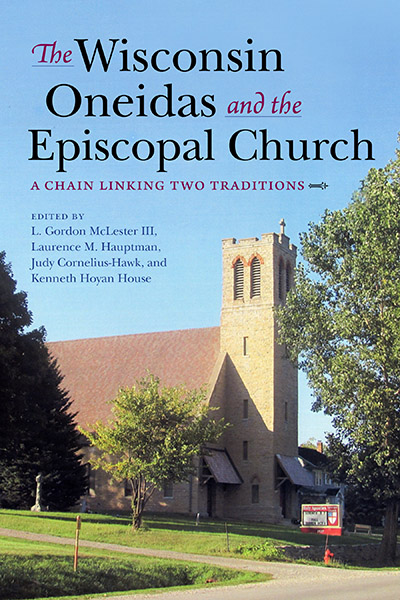A
review for Anglicans Online
by Richard Mammana
A review of
The Wisconsin Oneidas and the Episcopal Church: A Chain Linking Two Traditions
Edited by L. Gordon McLester III, Laurence M. Hauptman, Judy Cornelius-Hawk, and Kenneth Hoyan House. Indiana University Press. 2019.Softcover, 219 pages. US$35.00.
 "A chain of friendship is to be formed, which we trust will never be broken. We now extend to you the hand of the nation. We acknowledge you and will hereafter hold on to you as our loyal bishop."
"A chain of friendship is to be formed, which we trust will never be broken. We now extend to you the hand of the nation. We acknowledge you and will hereafter hold on to you as our loyal bishop."
With these words of four Oneida chiefs in 1839, Episcopal bishop Jackson Kemper received the promise of a "chain that would never become dim." This year’s Wisconsin Oneidas and the Episcopal Church offers ample evidence from a chorus of 24 (!) author-voices about the history and ongoing vitality of this relationship. The book builds on a number of rich sources and recent events:
- Thousands of pages of Oneida oral history compiled by the Works Progress Administration between 1938 and 1942, and the work of L. Gordon McLester III to videotape and digitize more than 500 additional interviews about all aspects of Oneida life.
- A 2014 celebration of the 175th anniversary of the Oneida Church of the Holy Apostles, sponsored by the Episcopal Diocese of Fond du Lac.
- Michael Leroy Oberg’s groundbreaking 2015 biography of the Reverend Eleazar Williams, a flawed and eccentric but major figure for Oneida contacts with the Protestant Episcopal Church, between the United States and Canada, and with the land speculators who would force the Oneida off their traditional lands in a series of expulsions between 1820 and 1845.
- A 2016 symposium of the Historical Society of the Episcopal Church, National Episcopal Historians and Archivists, and the Oneida Nation, with participation from the Canadian Church Historical Society and the Episcopal Women’s History Project.
The book is in four parts, the first three of which have editors' introductions. There is introductory attention to the Oneida world before Christianity, and to early Oneida relationships with missionaries of at least four kinds: Roman Catholic, Presbyterian, Methodist, and Anglican. Each of the next three sections has a specific focus on the history and experience of Oneida Episcopalians and the non-Oneida who have lived and worked among them in Wisconsin.
The first Anglican missionaries to work in traditional Oneida territory were sent during the reign of Queen Anne in 1704, and most Oneidas fought against the British Crown during the American Revolution. Beginning in the 1780s, the nation was dispossessed of at least five million acres of land during a series of treaties with the United States. Direct missionary work began with Bishop John Henry Hobart’s sending of a catechist to the Oneida in 1816. The current Church of the Holy Apostles, the center of Oneida Anglican life, was consecrated in 1920 to replace earlier structures dating to 1825, making this the oldest continuing place of Christian worship (outside of Roman Catholic settlements) in the Northwest Territory.
The Oneida experience of contact and life in a distinct Anglican environment has differences with that process of meeting in other indigenous and colonizing examples. It notably lacks the over-arching experience of residential school trauma among Canadian Anglicans and the efforts toward inculturation that have been underway within Anglican churches for Aboriginal Australians and Torres Straits Islanders. The editors acknowledge with honesty and pain that dynamics of exploitation, assimilation, and cultural replacement have been in place for the work of non-Oneida clergy among the Oneida during three centuries.
A significant aspect of the collection is its attention to one of the most neglected groups in American religious history: in this case the communities of women religious who worked among the Oneidas—the Community of St. Mary, the Order of S. Anne, the Sisterhood of the Holy Nativity, and the Order of the Teachers of the Children of God. Also notable is the inherently collaborative nature of the book, in which overlapping groups of academics, Oneida elders, and clergy of the Episcopal Church all write from their own sources of knowledge and experience with their own analytical and narrative tools.
Three essays stand out especially. Hauptman, McLester, and Cornelius-Hawk collaborate on “Another Leatherstocking Tale” about Susan Fenimore Cooper’s periodical and manuscript writings on early Oneida Episcopalians. Another collaborative essay on Cornelius Hill and John Archiquette entitled “Wearing Two Hats” looks at ordained and lay leadership. (Hill was the first ordained Oneida Episcopal priest and the last hereditary chief of his nation; Archiquette was a constable and Oneida vestryman.) Steven Peay’s overview of the relationship between the Oneida and theological education at Nashotah House seminary also covers new ground. The perspectives of material culture (lace making) and language preservation through hymn-singing in Oneida round out the volume before two contextualizing essays in conclusion.
Wisconsin Oneidas and the Episcopal Church was produced to a high technical standard with illustrations and maps, and it is more affordable than many books published through university presses. There are the usual small snags in footnotes and some slips in the correct use of clerical titles, but these little problems do not detract substantially from the larger project. The model of documentation, listening, symposia, liturgical expression, ecclesiastical and academic acceptance of a receiving and protecting role—all might be offered as methods for other books to describe the histories of the Episcopal Church in relation to the Navajo, the Cherokee, the Shoshone, the Arapahoe, the Gwich’in, the Mohawk, the Lakota and the Dakota, and perhaps most cognately in Hawai’i. The book deserves a wide audience across fields.